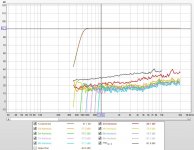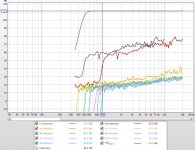ok thanks!
and a belated Happy New Year to you! ( may all your gigs this coming year have strong sober loaders!)
and a belated Happy New Year to you! ( may all your gigs this coming year have strong sober loaders!)
a question if i may, does a speaker's frequency response vary with volume?
I think it does, and probably at SPLs lower than we realize.
I think this is particularly true for home audio speakers with their relatively low sensitivity and power handling.
I hear compression and distortion on strong bass signals, and transients, when being driven at SPL levels that sound more realistic.
And even for pro audio with relatively much high sensitivity and power handling....
It always sounds brighter to me as I turn up the volume, even on gear that that's just reaching 10% distortion at about 130dB.
I think a spectral tilt happens that lowers the bottom end due to compression, and raises the top end due to increasing harmonic distortion.
Below are a couple of recently made distortion plots of a bms4594he / xt1464.
The SPL figures are correct @ 91 and 111dB, however they are at about 6" and need a 10-15dB reduction to normalize to 1 meter.
So let's just say we're down to about 70 and 90dB at listening distance....not that loud at all really....especially for transients.
Look at the distortion is rising on the 111dB trace --even at these relatively low drive levels, from a driver known for clean high output.
Sure, they are very low, very good numbers, and my dang noise floor was worse than anything....
but the point to me is, I inevitably hear sound brightening, even outdoors, when i crank it up.
So anyway, my 'brightening theory' is about rising high end distortion with volume, coupled with low end compression.
Meyer has a great test signal that's free called M-Noise if folks want to see how their system holds up without doing lots of sine sweeps. My neighbors think the sine sweeps are air-raid sirens haha.
Attachments
**SNIP**
but the point to me is, I inevitably hear sound brightening, even outdoors, when i crank it up.
**SNIP**
So anyway, my 'brightening theory' is about rising high end distortion with volume, coupled with low end compression.
It may also be some fletcher munson loudness action taking place. I imagine you're familiar but for those who aren't, the louder a "flat" sound source gets the louder the treble and bass sound.
Mark go over to the site I linked: Measurements and compare | HiFiCompass and have a look at some drivers and different drive levels. Let us know what you think.I think it does, and probably at SPLs lower than we realize.
It may also be some fletcher munson loudness action taking place. I imagine you're familiar but for those who aren't, the louder a "flat" sound source gets the louder the treble and bass sound.
I think I have never understood the relationship between Fletcher Munson curve and listening level. Is there any suggested EQ curve depends on the listening level?
Go to the link below and look at charts 4a and 4b. These show long term changes in frequency response from various compression effects.
SoundStage! Measurements - NXT Xd Loudspeaker System (7/2006)
There is no way to compare this to Chris' measurements without doing them under the same conditions.
SoundStage! Measurements - NXT Xd Loudspeaker System (7/2006)
There is no way to compare this to Chris' measurements without doing them under the same conditions.
Yes indeed! FWIW, JRiver now has a built in Loudness button that has more control than the old ON/OFF of yore. It can be useful. I've owned a few old radios where the volume control was also a progressive EQ. That's clever and helpful.
Pano interesting that you bring up that site as i've been looking at the limited data on it and comparing the response with level that is there, while i can concede on axis response varies little but thus far looking at off axis is more revealing, the variation is greater!
to wit other than locking our heads in a vise to obtain the same position as the measurement mic most of us in a real world situation are perceiving off axis response, so how is this not significant to what we hear?
to wit other than locking our heads in a vise to obtain the same position as the measurement mic most of us in a real world situation are perceiving off axis response, so how is this not significant to what we hear?
Go to the link below and look at charts 4a and 4b.
From this chart, I would guess that this speaker would sound punchy but a little harsh.
Interesting Jack- the 5" had issues at crossover with relatively low input power (95dB shouldn't take more than a couple dozen watts for the Xd midwoof I'd think).
The metal cone woofers in the subs for those- do you remember anything about the design? I actually am still using a pair of those subs (with the two diagonally oriented metal cone 12"s), and even have the active XO though it's not needed in my configuration.
Glad to see you here- I remember the NHT buyout as the last time I saw you on diy audio forums. That was what, 14 years back? Damn I'm old.
The metal cone woofers in the subs for those- do you remember anything about the design? I actually am still using a pair of those subs (with the two diagonally oriented metal cone 12"s), and even have the active XO though it's not needed in my configuration.
Glad to see you here- I remember the NHT buyout as the last time I saw you on diy audio forums. That was what, 14 years back? Damn I'm old.
Yes indeed! FWIW, JRiver now has a built in Loudness button that has more control than the old ON/OFF of yore. It can be useful. I've owned a few old radios where the volume control was also a progressive EQ. That's clever and helpful.
That's interesting. I have never seriously considered LOUDNESS control. 🙂
That, of course, is an important finding. I must have missed that, got any good examples?i can concede on axis response varies little but thus far looking at off axis is more revealing, the variation is greater!
Mark go over to the site I linked: Measurements and compare | HiFiCompass and have a look at some drivers and different drive levels. Let us know what you think.
Hi Pano, will do. Any particular drivers i should look at?
one that almost defies the on axis thing but must be due to thermal problems( ie power compression)
the Accuton S280-6-283N at 8V it exhibits an overall spl reduction ( according to supplied data)
the Accuton S280-6-283N at 8V it exhibits an overall spl reduction ( according to supplied data)
- Home
- Loudspeakers
- Multi-Way
- so you think loudspeakers are linear eh!

